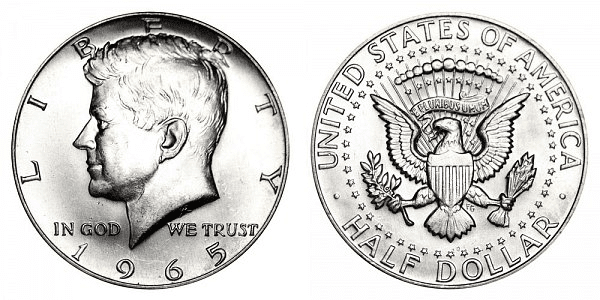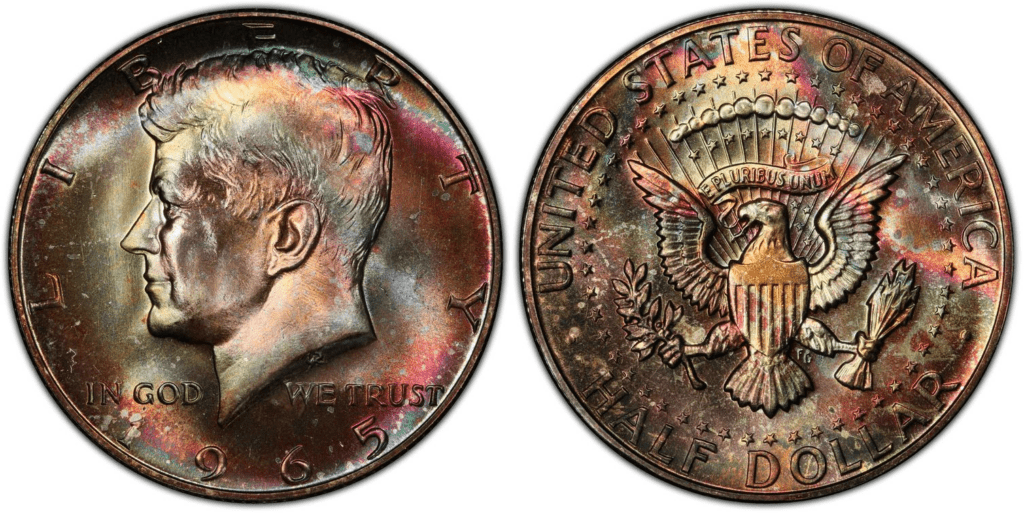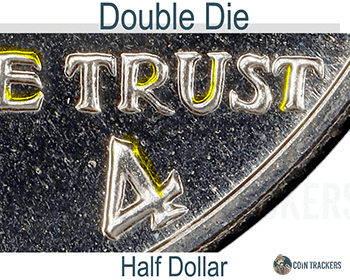What Is the 1965 Kennedy Half Dollar Made Of?
The United States Mint initially produced the Kennedy half dollar, a fifty-cent piece, in 1964. The coin is still produced today. A little more than a month after John F. Kennedy, the 35th president of the United States, was assassinated, Congress approved what was meant to be a memorial. The new coins were first created in January 1964 thanks to the Mint’s use of sculptures by artists Gilroy Roberts and Frank Gasparro that were already completed.
Both coin collectors and those desiring to pay tribute to the late president sought out the silver coins when they initially debuted in March 1964. The Mint considerably boosted production, but scarcely ever did anyone utilise the currency due to its highly collectable nature. When the value of silver rose, these coins were even more prized and were often melted down for their 90% silver content. Because of this, just a year after the production of the first Kennedy half dollar, the metal composition was changed to 40% silver and 60% copper, leading to a total weight of 11.5g. Despite this change, the half dollar remained highly collectable.
Gilroy Roberts created the coin’s obverse face, which features a profile bust of John F. Kennedy, the word “LIBERTY” along the top rim, and the year of mintage below. “IN GOD WE TRUST” is written on both sides of his neck. Frank Gasparro designed the reverse face, which shows a large-winged eagle holding an olive branch on one foot and a bundle of arrows in the other.
Above the eagle’s head, a banner bearing the words “E PLURIBUS UNUM” is displayed. It is encircled by a circle of stars. The words “HALF DOLLAR” and “UNITED STATES OF AMERICA” are printed on either side of the upper rim.
Kennedy half dollars are still in production today but are mainly reserved for collectable special mint sets and special commemorative coins.
In 1965 the St. Louis Arch was finished, the space race was in hotting up, the Rolling Stones were on tour across the world, the Voting Rights Act was passed as a result of the courage of those who participated in the Selma march, and the Vietnam War was intensifying.
Malcolm X was slain, NASA’s Mariner 4 flew by Mars, race riots broke out in Watts, California, and Muhammad Ali fought Sonny Liston. The United States also invaded the Dominican Republic.
1965 Kennedy Half Dollar Varieties
1965 Kennedy Half Dollar
Edge: 150 Reeds
Place of minting: Philadelphia (and Denver from 30th December)
Year of minting: 1965
Face Value: $0.50
Quantity produced: 65,879,366
Composition: 40% silver and 60% copper
Mass: 50 grams
Diameter: 15 millimeters
Thickness: 6 millimeters

As mentioned, the high rise in the popularity of coin collecting, combined with the nations’ love of JFK led to a severe coin shortage. In addition to this, with increased silver costs, the Senate agreed to the Coinage Act of 1965, which not only reduced the precious metal content in all denominations of coin, but saw the mint mark removed from all coins. These steps were intended to reduce the collectable appeal of coins to budding collectors, and thus put more coins back into circulation, and the changes to mint mark ruling remained for 5 years. Luckily for modern numistmatists, the coin collectors of the past were stubborn, and the passion for coin collecting remained strong throughout these challenging years.
1965 Kennedy Half Dollar Proof
Edge: 150 Reeds
Place of minting: Philadelphia
Year of minting: 1965
Face Value: $0.50
Quantity produced: 2,300,000
Composition: 40% silver and 60% copper
Mass: 50 grams
Diameter: 15 millimeters
Thickness: 6 millimeters

Despite the lack of mint marks, a proof run of the 1965 Half Dollar was still produced.
List Of 1965 Kennedy Half Dollar Errors

There are no widespread noted errors seen in the 1965 Kennedy Half Dollars. Instead, the errors found by collectors vary from coin to coin, with the most common being a double-die error as seen above.
How Much Is the 1965 Kennedy Half Dollar Worth Today?
The 1965 Kennedy Half Dollar coin is worth at least its weight in silver in circulating condition. As of January 10, 2023, this coin’s silver melt value is $3.50. (Based on the current silver spot price of $23.64 per ounce).
Uncirculated Kennedy half dollars make up the majority of the available inventory of these coins, however. These coins were first saved by collectors, hence the majority were never used in commerce.
| Coin | Condition
Circulated/Uncirculated? Mint or Proof? |
Grade | Mintage | Value |
| 1965 Kennedy Half Dollar | Circulated | G4-AU50 | 65,879,366 | $5.25 |
| 1965 Kennedy Half Dollar | Uncirculated | MS60-65 | 65,879,366 | $7.99-18 |
| 1965 Kennedy Half Dollar Proof | MS64-67 | Uncirculated | 2,300,000
|
$16-70 |
How Does The Grading System Work?
The Sheldon Scale is used by numismatists to provide a numerical value to coins. The Sheldon Scale goes from poor (P-1) to perfect mint state (P-1) (MS-70). Coins were originally evaluated using words to reflect their condition (Good, Fair, Excellent, Etc.). Unfortunately, coin collectors and dealers had different ideas about what each of these terms represent.
Professional numismatists joined together in the 1970s and established coin grading standards. These numismatists now assign grades at key places on the seventy-point scale, using the most regularly utilized numeric points in conjunction with the original adjective grade. The following are the most common coin grades:
- (P-1) Poor – Indistinguishable and probably damaged; if used, must have a date and mintmark; otherwise, rather battered.
- (FR-2) Fair – Nearly smooth, but without the damage that a coin graded Poor often possesses. The coin must have enough detail to be identified.
- (G-4) Fair – Inscriptions have merged into the rims in some areas, and important elements have been mostly erased.
- (VG-8) Very Good- A little weathered, but all of the primary design elements are visible, albeit faintly. There is little if any, central detail left.
- (F-12) Good – The item is very worn, yet the wear is even, and the overall design details stand out clearly. Rims are almost completely isolated from the field.
- (VF-20) Very Fine – Moderately weathered, with some finer features still visible. The motto or all letters of LIBERTY are readable. Both sides of the coin have entire rims that are separated from the field.
- (EF-40) Extremely Fine – Gently used; all gadgets are visible, and the most important ones are bold. The finer details are bold and clear, however, light wear may be seen.
- (AU-50) Uncirculated – Slight evidence of wear on the coin’s design’s high points; may have contact marks; eye appeal should be adequate.
- (AU-58) Uncirculated Choice – Slight traces of wear, no severe contact marks, almost full mint shine, and great eye appeal.
- (MS-60) Mint State Basal – Strictly uncirculated; no indication of wear on the coin’s highest points, but an unsightly coin with reduced luster, visible contact marks, hairlines, and other flaws.
- (MS-63) Mint State Acceptable – Uncirculated, but with contact scratches and nicks, little reduced shine, but otherwise appealing appearance. The strike is weak to average.
- (MS-65) Mint State Choice – Uncirculated with great mint shine, very little contact blemishes, and exceptional eye appeal. The strike is unusually severe.
- (MS-68) Mint State Premium Quality – Uncirculated with superb luster, no obvious contact marks to the naked eye, and exceptional eye appeal. The strike is quick and appealing.
- (MS-69) Almost Perfect Mint State – Uncirculated with perfect brilliance, a sharp and appealing strike, and extremely good eye appeal. A near-perfect coin with minor imperfections in the planchet, strike, and contact markings (seen only under 8x magnification).
- (MS-70) Mint State Perfect – Under 8x magnification, there are no tiny imperfections discernible; the strike is crisp, and the coin is perfectly centered on a beautiful planchet. Rarely seen on a coin, this coin is bright and whole, with original luster and exceptional eye appeal.
Where To Buy Or Sell 1965 Kennedy Half Dollar?
Due to the low quantity of rare or extraordinary coins found in this mintage year, the majority of examples of 1965 Half Dollars can be bought and sold online. Only if you think your coin has exceptional qualities should you consider visiting speciality shops, auctions, or dealers. If you’re unclear about the rarity of your 1965 half dollar, coin-collecting websites like the U.S. Coin Forum are a fantastic location to ask questions. To grade your coin, services like PCGS are advised.
FAQs
Is a 1965 half-dollar 90% silver?
No, 1965 was the first year that the Coinage Act of 1965 came into effect which saw the reduction of silver content across the board. In the case of the half dollar, the silver content was reduced to 40%.
What is the difference between circulated and uncirculated 1965 Kennedy half dollars?
The main two differences between the circulated and uncirculated half dollars are the condition, and because of this the price. When it comes to coin collecting, typically the closer to mint that a coin is the better its projected value.
How can you tell if a 1965 half-dollar is silver?
The date alone is typically enough to tell if your coin is silver, however, you can also confirm the silver content of your coin by weighing it, as coins without a silver content tend to be far lighter.
